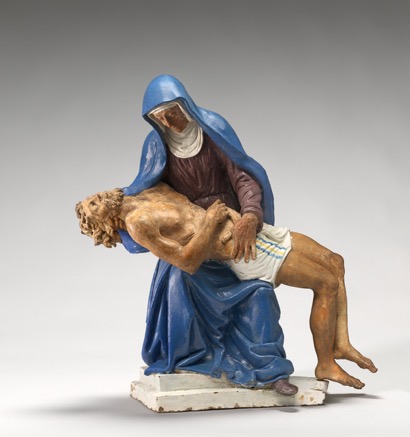Meeting Summary: Unexpected Discovery of Challacolloite (KPb2Cl5) in Giovanni della Robbia’s Painted Terracotta, Pietà
Presenter: Xiao Ma, Charles E. Culpeper Fellow in Conservation Science, National Gallery of Art. WCG Intern talks. April 5, 2018 at the MacMillan Education Center, Smithsonian American Art Museum.
Summarized by: Mary Wilcop, graduate fellow in the Buffalo State College art conservation program and third-year intern at the National Museum of American History, Smithsonian Institution

Xiao Ma, Conservation Science Fellow at the National Gallery of Art, presented recent findings from his research into the analysis of materials used in the sculpture Pietà by Italian ceramic artist Giovanni della Robbia.
Small samples were taken from three painted areas on the terracotta sculpture and analyzed using optical microscopy, Fourier transform infrared spectroscopy (FTIR), and scanning electron microscopy (SEM). In FTIR, common minerals such as gypsum and calcite were readily detected. Backscatter electron imaging (BSE) showed the presence of a material with a relatively high atomic number. Energy-dispersive x-ray spectroscopy (SEM-EDX) clarified that this material was likely a compound comprised of lead, potassium, and chlorine, however no lead white was detected by FTIR. In optical microscopy and SEM, Xiao found that the crystals were a few microns in size and had polyhedral facets.
The sample was further analyzed by both Raman spectroscopy and electron backscatter diffraction (EBSD). Considering all of the analysis together, Xiao concluded that this unusual material was the rare halide mineral challacolloite, which has the elemental formula KPb 2 Cl 5. It is difficult to identify challacolloite using FTIR alone, as it shows no bands in the 600-4000 cm -1 region.
It was at this point that he asked, what is challacolloite? Challacolloite is a very rare mineral that was first identified from the Challacollo Mine in Chile. Since then, it has also been found occurring naturally near the sites of volcanic eruptions such as Mount Vesuvius in Italy and near the Kudryavi and Satsuma-Iwojima volcanoes in Japan. In recent years, challacolloite has been grown artificially in laboratories and used in the manufacture of lasers.

Next, Xiao questioned where in the layering of the della Robbia sculpture was the challacolloite distributed, and how was it forming? In stratigraphic SEM-EDX mapping of his samples, Xiao found challacolloite throughout the cross-sections. Further researching the literature, he learned that challacolloite has also been found by a research group at the Yale Institute for the Preservation of Cultural Heritage on a fifteenth-century polychrome terracotta relief by Michele da Firenze. As the material is a halide salt, its presence could potentially present problems for the structural integrity of the terracotta. Based on his research, Xiao believes the mineral could be a result of the deterioration of lead white in the object. Currently, he is working on determining the mechanism for the salt formation by creating and testing mock-up materials.
Xiao concluded his talk by emphasizing to the WCG group that if any conservators encounter a Pb-K-Cl compound on their object in the future, to please let him know!
